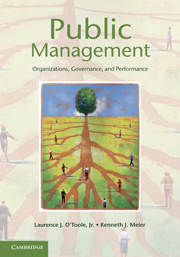Book contents
- Frontmatter
- Contents
- List of figures
- List of tables
- Preface
- 1 Public management and performance: an evidence-based perspective
- 2 A model of public management and a source of evidence
- 3 Public management in interdependent settings: networks, managerial networking, and performance
- 4 Managerial quality and performance
- 5 Internal management and performance: stability, human resources, and decision making
- 6 Nonlinearities in public management: the roles of managerial capacity and organizational buffering
- 7 Public management in intergovernmental networks: matching structural networks and managerial networking
- 8 Public management and performance: what we know, and what we need to know
- Glossary
- References
- Index
7 - Public management in intergovernmental networks: matching structural networks and managerial networking
Published online by Cambridge University Press: 05 June 2012
- Frontmatter
- Contents
- List of figures
- List of tables
- Preface
- 1 Public management and performance: an evidence-based perspective
- 2 A model of public management and a source of evidence
- 3 Public management in interdependent settings: networks, managerial networking, and performance
- 4 Managerial quality and performance
- 5 Internal management and performance: stability, human resources, and decision making
- 6 Nonlinearities in public management: the roles of managerial capacity and organizational buffering
- 7 Public management in intergovernmental networks: matching structural networks and managerial networking
- 8 Public management and performance: what we know, and what we need to know
- Glossary
- References
- Index
Summary
In this book on public management and performance, we began by noting the importance of networked relationships among organizations as a key part of contemporary public managers' institutional settings. We also explored at length the question of how what managers actually do shapes the results of public programs. We have analyzed managerial networking behavior, among other aspects of management, but thus far we have not assessed how networked structures themselves – as distinct from the networking behavior of managers – shape policy outputs and outcomes. To put it in terms of the elements of our model, we have unpacked several elements of “M” but largely ignored the structural aspects of the core organization's environment – an aspect of the “X” term.
The reasons for this focus were explained in Chapter 2, and it should be clear from the extensive reliance of our empirical exploration on the Texas school district data set that researchers inevitably face real limitations in fully exploring structural influences with such a sample. School districts internally look much like each other in structural terms, so the range of variation is quite limited. Moreover, sketching the full networks in which they may operate would require labor-intensive data gathering among many actors in each of the more than 1,000 districts in the sample. The task is not practical without large amounts of time and resources for extensive fieldwork.
- Type
- Chapter
- Information
- Public ManagementOrganizations, Governance, and Performance, pp. 240 - 266Publisher: Cambridge University PressPrint publication year: 2011



